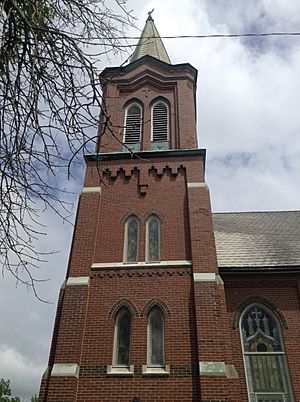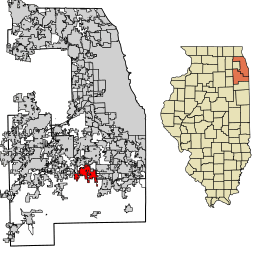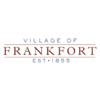Frankfort, Illinois facts for kids
Quick facts for kids
Frankfort, Illinois
|
|||
|---|---|---|---|
|
Village
|
|||

St. Peter's United Church of Christ, Frankfort
|
|||
|
|||

Location of Frankfort in Will and Cook Counties, Illinois
|
|||
| Country | |||
| State | Illinois | ||
| Counties | Will, Cook | ||
| Townships | Frankfort, Rich | ||
| Incorporated | 1879 | ||
| Government | |||
| • Type | Mayor-Council | ||
| Area | |||
| • Total | 15.79 sq mi (40.91 km2) | ||
| • Land | 15.79 sq mi (40.91 km2) | ||
| • Water | 0.00 sq mi (0.00 km2) 0% | ||
| Population
(2020)
|
|||
| • Total | 20,296 | ||
| • Density | 1,285.04/sq mi (496.14/km2) | ||
| Standard of living (2010-2014) | |||
| • Per capita income | $41,832 | ||
| • Median home value | $348,600 | ||
| ZIP code(s) |
60423
|
||
| Area code(s) | 815 | ||
| Geocode | 27624 | ||
| FIPS code | 17-27624 | ||
Frankfort is a village located in Will County and Cook County, Illinois. It's a suburb south of Chicago, about 28 miles (45 km) away. In 2020, about 20,296 people lived there.
Frankfort has a historic downtown with places like the Frankfort Grainery and Breidert Green. You can also find part of the Old Plank Road Trail here. This trail is 22 miles long and is great for recreation. The village also has Commissioners Park and several schools. These include Lincoln-Way East High School, Hickory Creek Middle School, and Dr. Julian Rogus School.
Contents
- What's in a Name? The Story of Frankfort
- Frankfort's Past: A Look at Its History
- Where is Frankfort Located?
- Who Lives in Frankfort? Understanding Demographics
- Getting Around: Transportation in Frankfort
- Learning in Frankfort: Schools and Education
- Famous Faces: Notable People from Frankfort
- See also
What's in a Name? The Story of Frankfort
The name "Frankfort" comes from Frankfort Township. This township was named by the Will County board. People often called it "Frankfort Station" after a railroad opened in 1855. However, official documents always showed the name as "Frankfort." Local residents officially made Frankfort a village in 1879. The name also connects to the big German city of Frankfurt.
Frankfort's Past: A Look at Its History
Early Settlers and Native American Connections
Long ago, Native American tribes like the Potawatomi and Sac and Fox lived in the Frankfort area. They used the land as a path between the Des Plaines and St. Joseph rivers. The area was first part of the Virginia Territory. Later, the French signed a deal with Manitoqua, a Potawatomi chief, for land nearby. The first pioneers arrived in Frankfort in the early 1830s. They traveled by river or by wagon along the Sauk Trail, which is still a road today.
William Rice was the first non-native person to settle permanently in Frankfort in 1831. Early pioneers came mostly from New England. They were mainly of English and Scottish backgrounds. But it was German settlers who truly helped create the village of Frankfort.
German Settlers and Farming Life
In the 1840s, more German settlers came to Frankfort from Germany. They had left difficult conditions in their home country. These settlers were very hardworking and skilled farmers. They soon bought most of the good farmland from the earlier settlers. The German settlers were proud of the area. They started the first system for residents to care for local lands. This tradition has continued ever since.
How Frankfort Became a Village
What we now call Frankfort Township was once part of the Hickory Creek Precinct. In 1850, Will County changed its government to a township system. Frederick Cappel named Frankfort Township after his hometown, Frankfurt am Main, Germany.
In 1855, the Joliet and Northern Indiana Railroad built a railway line. This line connected Joliet, Illinois with Lake Station, Indiana. The Michigan Central Railroad leased the J&NI line, and train service began in July 1855. Nelson D. Elwood, a railroad officer, and Sherman Bowen, a lawyer, planned a village of about 23 acres in March 1855. They named it Frankfort after the township. People often called it "Frankfort Station" because of the train depot. But when the village officially formed, "station" was dropped from the name.
John McDonald became the first railroad agent in 1857. In 1879, Frankfort officially became a village. John McDonald was elected as its first Village President. One of the first things the new government did was create rules for how land could be used. Early plans showed a grid pattern for the village. Homes were built around the business area and railroad line. Land was also set aside for schools and public parks.
Where is Frankfort Located?
Frankfort is located at coordinates 41.498133 degrees North and -87.849549 degrees West. It covers a total area of about 15.79 square miles (40.91 square kilometers), all of which is land.
Frankfort is part of the larger Chicago Metropolitan area. It is about 28 miles south of the city of Chicago. North of Frankfort village, there's an area called Frankfort Square. It's a census-designated place within Frankfort Township.
Frankfort shares its borders with several other towns. To the east is Richton Park. To the northeast are Tinley Park, Frankfort Square, and Matteson. To the west are Mokena and New Lenox. Finally, to the southeast are Monee and University Park.
Who Lives in Frankfort? Understanding Demographics
| Historical population | |||
|---|---|---|---|
| Census | Pop. | %± | |
| 1880 | 332 | — | |
| 1890 | 431 | 29.8% | |
| 1900 | 250 | −42.0% | |
| 1910 | 273 | 9.2% | |
| 1920 | 497 | 82.1% | |
| 1930 | 590 | 18.7% | |
| 1940 | 568 | −3.7% | |
| 1950 | 685 | 20.6% | |
| 1960 | 1,135 | 65.7% | |
| 1970 | 2,325 | 104.8% | |
| 1980 | 4,357 | 87.4% | |
| 1990 | 7,180 | 64.8% | |
| 2000 | 10,391 | 44.7% | |
| 2010 | 17,782 | 71.1% | |
| 2020 | 20,296 | 14.1% | |
| U.S. Decennial Census 2010 2020 |
|||
According to the 2020 census, 20,296 people lived in Frankfort. There were 6,072 households and 5,305 families. The population density was about 1,285 people per square mile. There were 6,902 housing units in the village.
Most residents, about 80.96%, were White. About 8.65% were African American, and 3.25% were Asian. A small number were Native American or Pacific Islander. About 1.30% were from other races, and 5.70% were from two or more races. People of Hispanic or Latino background made up 5.38% of the population.
Out of all households, 44.6% had children under 18 living with them. Most households (79.83%) were married couples. The average household had 3.42 people, and the average family had 3.13 people.
The village's population had different age groups. About 29.7% were under 18 years old. 6.6% were 18 to 24, and 16.7% were 25 to 44. About 30.7% were 45 to 64, and 16.3% were 65 or older. The average age was 41.9 years.
The median income for a household in Frankfort was $140,731. For a family, it was $151,518. The average income per person was $51,278. About 2.3% of families and 2.6% of the total population lived below the poverty line. This included 3.1% of those under 18 and 1.2% of those 65 or older.
| Race / Ethnicity (NH = Non-Hispanic) | Pop 2000 | Pop 2010 | Pop 2020 | % 2000 | % 2010 | % 2020 |
|---|---|---|---|---|---|---|
| White alone (NH) | 9,592 | 15,234 | 16,168 | 92.31% | 85.67% | 79.66% |
| Black or African American alone (NH) | 257 | 1,085 | 1,738 | 2.47% | 6.10% | 8.56% |
| Native American or Alaska Native alone (NH) | 11 | 16 | 9 | 0.11% | 0.09% | 0.04% |
| Asian alone (NH) | 221 | 462 | 659 | 2.13% | 2.60% | 3.25% |
| Pacific Islander alone (NH) | 0 | 2 | 1 | 0.00% | 0.01% | 0.00% |
| Other race alone (NH) | 17 | 12 | 41 | 0.16% | 0.07% | 0.20% |
| Mixed race or Multiracial (NH) | 53 | 156 | 589 | 0.51% | 0.88% | 2.90% |
| Hispanic or Latino (any race) | 240 | 815 | 1,091 | 2.31% | 4.58% | 5.38% |
| Total | 10,391 | 17,782 | 20,296 | 100.00% | 100.00% | 100.00% |
Getting Around: Transportation in Frankfort
Major Roads and Highways
Frankfort has important roads that help people travel.
 US 45 (also called La Grange Road) is a main road running north and south through Frankfort. It crosses Lincoln Highway.
US 45 (also called La Grange Road) is a main road running north and south through Frankfort. It crosses Lincoln Highway. US 30 (Lincoln Highway) is a main road running east and west through Frankfort.
US 30 (Lincoln Highway) is a main road running east and west through Frankfort. CR 74 (Laraway Road) is a county highway that runs east and west through the southern part of Frankfort.
CR 74 (Laraway Road) is a county highway that runs east and west through the southern part of Frankfort.
Learning in Frankfort: Schools and Education
Frankfort School District 157C and Summit Hill District 161 serve the students in Frankfort. In 2018, Hickory Creek Middle School, part of District 157C, was ranked 5th best in the state.
Frankfort is also home to Lincoln-Way East High School. This high school has won many state championships! Their teams have won in Football (2005, 2017, 2019), Girls Softball (2002), Boys Gymnastics (2006, 2011), Girls Track & Field (2014, 2015, 2016), and Girls Cheerleading (2014, 2015, 2017). Their Marching Band also won in 2007 and 2008. Lincoln-Way North, another local school, won state championships in Boys Gymnastics (2011) and Summer League Baseball (2011).
Famous Faces: Notable People from Frankfort
Many interesting people have lived in Frankfort:
- Nick Allegretti: A guard who plays for the Kansas City Chiefs football team.
- Lou Boudreau: A Hall of Fame baseball player.
- Dennis DeYoung: The former lead singer of the rock band Styx.
- Dan Giordano: A former linebacker for the Arizona Cardinals football team.
- Jason Vander Laan: A football tight end who played for the Carolina Panthers.
- Erika Lauren: A cast member from MTV’s The Real World: D.C. and a former radio personality.
- George E. Sangmeister: (1931–2007) He was a member of the United States House of Representatives from Illinois. He grew up in Frankfort, and his father was once the mayor.
See also
 In Spanish: Frankfort (Illinois) para niños
In Spanish: Frankfort (Illinois) para niños



